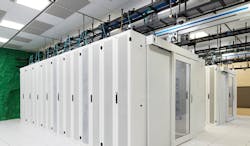We continue our series of stories on the leading geographic markets for data center space. Data Center Frontier is partnering with datacenterHawk to provide in-depth market reports on each city we profile. This time, we visit the Denver Data Center Market, one of the fastest-growing technology ecosystems in the U.S. The second post in our series explores how demand in this market is being driven by local tech startups.
Download the full report.
Demand in Denver typically comes from within the region or from West Coast centers looking for disaster recovery (DR) locations as businesses shift from enterprise or on-premise infrastructure to third-party data centers. Denver’s current primary industries (transportation, technology, telecommunications, aerospace, farming, and financial services) create consistent retail demand, keeping the area’s vacancy rate healthy.
Due to the higher costs of doing business, companies outside Denver typically choose to house their data center infrastructure in the area more on the basis of need rather than desire.
Data center demand in Denver traditionally is focused on retail colocation, with few transactions exceeding 500 kW, although some recent deals are starting to push into wholesale territory as more capacity comes online.
Much of Denver’s capacity currently under construction is tied to demand from local tech startups thanks to the regions numerous technology incubator programs.
Several providers in Denver are positioning themselves to bring wholesale data center space to the area. Some examples:
- Iron Mountain’s Denver data center, acquired through its purchase of FORTRUST, is a 179,000 square foot/16-megawatt colocation facility that accommodates retail, wholesale, and modular data center demand.
- Flexential’s Compark facility features a single 148,000 SF data hall, reflecting recent trends toward larger data halls.
- EdgeConneX has built a 115,000 SF powered shell at its Englewood campus, continuing a pattern of building larger second data centers at its edge network locations.
- H5 can support wholesale and retail requirements at its Greenwood Village campus, where it has invested about $20 million in improvements.
Between these facilities, Denver can deploy and absorb over 50 MW of wholesale power.
So, with Denver’s largest industries creating consistent-but-modest data center demand, who will pickup this wholesale capacity? Much of Denver’s capacity currently under construction is tied to demand from local tech startups thanks to the regions numerous technology incubator programs. Also, as one of the 20 largest U.S. metropolitan areas in terms of population, Denver generates a large amount of data, which requires storage and processing.
Denver’s important role in edge computing, putting data centers in areas with high populations in order to reduce latency and load on long-haul fiber lines, will help ensure short and long-term future demand for colocation services. As one of the largest and most connected cities in the region, Denver is a good candidate for handling the region’s traffic. For most of the mountain states, the closest major markets besides Denver would be Phoenix, Dallas, or Northern California, which are all too far away to provide a true low latency connection.
In terms of notable deals, Flexential recently added a new tenant to its Denver data center, with AsTech selecting the company for data center services in Dallas and Denver. AsTech initiated their relationship with Flexential in Dallas, where they have hybrid colocation and cloud infrastructure. In an expansion of the relationship, the company chose to duplicate their infrastructure in Flexential’s Denver data center to serve as a disaster recovery location. Since capacity is often absorbed from existing users renewing and expanding their contracts, developing long-term relationship with their users is key for data center providers.
Iron Mountain, who rarely announces customer wins due to privacy concerns, added it has seen demand from the healthcare and financial services industries as well as sustained demand from the cloud and IT services space.
H5 announced in mid-2018 that it has leased a dedicated 5,000 square foot suite at its Denver Tech Center campus to an existing Fortune 500 customer.
The Denver Data Center Market Report will also cover the following topics:
- Market View and Analysis
- Trends in Supply
- Business Environment
Download the full Data Center Frontier “Denver Data Center Market” special report, courtesy of Iron Mountain Data Centers.
About the Author



